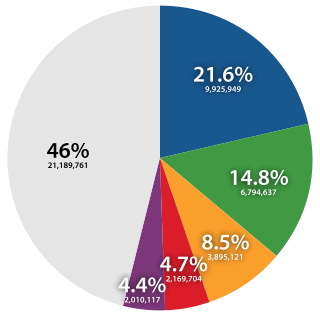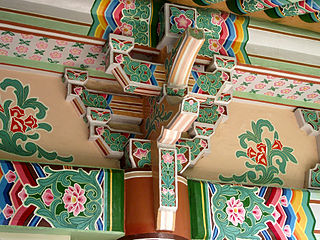Related Research Articles

Korean Confucianism is the form of Confucianism that emerged and developed in Korea. One of the most substantial influences in Korean intellectual history was the introduction of Confucian thought as part of the cultural influence from China.

Lee,I,or Yi (이) is the second-most-common surname in Korea,behind Kim (김). As of the South Korean census of 2015,there were 7,306,828 people by this name in South Korea or 14.7% of the population.

Gyeongju,historically known as Seorabeol,is a coastal city in the far southeastern corner of North Gyeongsang Province,South Korea. It is the second largest city by area in the province after Andong,covering 1,324 km2 (511 sq mi) with a population of 264,091 people as of December 2012. Gyeongju is 370 km (230 mi) southeast of Seoul,and 55 km (34 mi) east of Daegu. The city borders Cheongdo and Yeongcheon to the west,Ulsan to the south and Pohang to the north,while to the east lies the coast of the Sea of Japan. Numerous low mountains—outliers of the Taebaek range—are scattered around the city.

Andong is a city in South Korea,and the capital of North Gyeongsang Province. It is the largest city in the northern part of the province with a population of 167,821 as of October 2010. The Nakdong River flows through the city. Andong is a market centre for the surrounding agricultural areas.

Miryang,formerly also spelled as 推火郡,Milbeol (密伐) and Milseong (密城),is a city in Gyeongsangnam-do Province,South Korea. Its name is originated from the tribal country named Miri midong guk (彌離彌凍國). There are various hypotheses as to the meaning of Miryang,such as Milky Way,Galaxy,dragon's field,Wheat Field and the watery field. Neighboring cities include Changnyeong to the west,Cheongdo to the north,Ulsan to the east,and Yangsan,Gimhae,and Changwon to the south. The city bird is the Korean magpie,the city tree is the pine,and the city flower is the royal azalea.

Korean architecture refers to an architectural style that developed over centuries in Korea. Throughout the history of Korea,various kingdoms and royal dynasties have developed a unique style of architecture with influences from Buddhism and Korean Confucianism.

Seowon (Korean: 서원) were the most common educational institutions of Korea during the Joseon Dynasty. They were private institutions,and combined the functions of a Confucian shrine and a Confucian school. In educational terms,the seowon were primarily occupied with preparing young men for the national civil service examinations. In most cases,seowon served only pupils of the aristocratic yangban class. On 6 July 2019,UNESCO recognized a collection of nine seowon as World Heritage Sites.

Hyanggyo (Korean: 향교) were government-run provincial Confucian schools established during the Goryeo (918–1392),and Joseon periods in Korea. They were established to educate and train officials in Confucian ideals and the ethics of government. In the Joseon period,when Neo-Confucianism replaced Buddhism as the ruling ideology,the government needed to promote the new ideology to create a new social order based on Neo-Confucianism. During this period also,teachers at Hyanggyo received land,royalties,and slaves from the government.

Beopju is a type of cheongju. The name literally means "law liquor",as it is made following a fixed procedure. On 1 November 1986,a variety called Gyodong-beopju was designated by the government of South Korea as Intangible Cultural Property.
Tourism in Gyeongju is a major industry and defining feature of Gyeongju,South Korea. Gyeongju is a major cultural site and tourist destination for South Koreans and foreigners with about 8 to 9 million visitors annually. A great deal of this is due to the city's status as a center of Silla heritage,derived from its former role as the capital of that ancient kingdom.
Gyeongju is a coastal city in the far southeastern corner of North Gyeongsang province in South Korea. It is the second largest city by area in the province after Andong,covering 1,324 square kilometres (511 sq mi) with a population of 269,343 people according to the 2008 census. The early history of Gyeongju is closely tied to that of the Silla kingdom,of which it was the capital for nearly one thousand years.

Yangdong Folk Village (Korean: 경주양동민속마을),or Yangdong Village of Gyeongju,is a traditional yangban village from the Joseon dynasty. The village is located in Gangdong-myeon,sixteen kilometers northeast of Gyeongju,Gyeongsangbuk-do,South Korea,along the Hyeongsan River. Mt. Seolchang stands to the north of the village. The village is designated as Important Folklore Materials No. 189 by the South Korean government.

The Seoak Seowon is a seowon located in the neighborhood of Seoak-dong,Gyeongju,North Gyeongsang Province,South Korea. Seowon was a type of local academy during the Joseon Dynasty (1392–1897). It was established by local Confucian scholars especially Yi Jeong in 1651,the second year of King Hyojong's reign,to commemorate the virtue and scholarly achievements of scholar Seol Chong,and Ch'oe Ch'i-wŏn and General Kim Yu-sin. The enshrined people played important roles in the unification of Three Kingdoms of Korea into Unified Silla.

The Gyeongju Hyanggyo is a hyanggyo or government-run provincial school during the Goryeo and Joseon periods,which is located the neighborhood of Gyo-dong,Gyeongju,North Gyeongsang province,South Korea. The foundation date is unknown,but was established to enshrine the memorial tablet of a wise Confucian scholar and to commemorate him as well as to provide mid-leveled education to the local during the Goryeo period. The site was originally the place where the Gukhak,or national academy of the Silla kingdom was situated. The Gukhak was built in 682,the second year of King Sinmun's reign and is equivalent to current national universities. It is designated to the 191st Tangible Cultural Property of North Gyeongsang province.

Gwangajeong is an old hanok,or Korean traditional house located in Yangdong village,Gangdong-myeon,Gyeongju,South Korea. It was the house of Son Jung-don,a civil minister during the reign of King Seongjong of the Joseon Dynasty. It is designated as the 442 Treasure of South Korea. Sarangchae and anchae of the house are arranged in a rectangular shape looking to the west whereas a shrine is located facing to northeast. The hanok is regarded as a good example for studying houses built in the mid Joseon period.
Gyo-dong is a dong or neighborhood in the metropolitan city of Daegu,South Korea. It is one of legal dong under its administrative dong Seongnae 1-dong's jurisdiction. The name,Gyo-dong originates from the fact that the area has had a hyanggyo,government-managed Confucian academies during the Joseon period. It belonged to Dongsang-myeon,Daegu-bu during the Joseon Dynasty
Gyo-dong is a dong or neighborhood in the city of Gongju,South Chungcheong province,South Korea. It is one of legal dong under its administrative dong Ungjin-dong's jurisdiction.

The Goheung Hyanggyo was founded in 1441,during the reign of Joseon Dynasty King Sejong. In 1597 the school was heavily damaged during the Second Japanese Invasion. In 1695 it was moved to the present site and restored with the help of Confucian students from Seongdong town.

The Jeonju Hyanggyo is a hyanggyo (school) originally established at the Gyeonggijeon Shrine site in Jeonju,Korea,sometime early in the 15th century,during the Joseon Dynasty (1392-1910). Gyeonggijeon Shrine was erected in 1410,so construction of the Jeonju Hyanggyo had to follow sometime later.

Jeonju Hanok Village is a village in the city of Jeonju,South Korea,and overlaps with the Pungnam-dong and Gyo-dong neighborhoods. The village contains over 800 Korean traditional houses called Hanok. The village is famous among Koreans and tourists because of its traditional buildings that strongly contrast with the modern city around it. The village was designated as an International Slow City in 2010 in recognition of its relaxed pace of life where traditional culture and nature blend harmoniously. The number of visitors to Jeonju Hanok Village has increased sharply since the 2000s. The visitor numbers more than doubled from 2007 to 2014,from 3.17 million to 7.89 million. Excluding Seoul,Jeonju is ranked third among major tourist cities throughout Korea,behind Jeju and Busan.
References
- 1 2 3 교동 Gyo-dong 校洞 [ permanent dead link ] (in Korean) Doosan Encyclopedia
- ↑ "Archived copy". Archived from the original on 2011-10-08. Retrieved 2009-09-14.
{{cite web}}: CS1 maint: archived copy as title (link)